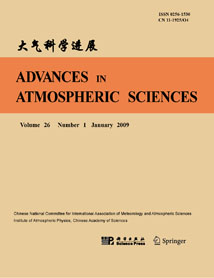| [1] |
Xiaolei CHEN, Yimin LIU, Guoxiong WU,
2017: Understanding the Surface Temperature Cold Bias in CMIP5 AGCMs over the Tibetan Plateau, ADVANCES IN ATMOSPHERIC SCIENCES, 34, 1447-1460.
doi: 10.1007s00376-017-6326-9
|
| [2] |
Jiang Hao, Wang Keli,
2001: Analysis of the Surface Temperature on the Tibetan Plateau from Satellite, ADVANCES IN ATMOSPHERIC SCIENCES, 18, 1215-1223.
doi: 10.1007/s00376-001-0035-z
|
| [3] |
ZHONG Lei, MA Yaoming, Zhongbo SU, Mhd. Suhyb SALAMA,
2010: Estimation of Land Surface Temperature over the Tibetan Plateau Using AVHRR and MODIS Data, ADVANCES IN ATMOSPHERIC SCIENCES, 27, 1110-1118.
doi: 10.1007/s00376-009-9133-0
|
| [4] |
MA Yaoming, WANG Binbin, ZHONG Lei, MA Weiqiang,
2012: The Regional Surface Heating Field over the Heterogeneous Landscape of the Tibetan Plateau Using MODIS and In-Situ Data, ADVANCES IN ATMOSPHERIC SCIENCES, 29, 47-53.
doi: 10.1007/s00376-011-1008-5
|
| [5] |
Nan GE, Lei ZHONG, Yaoming MA, Yunfei FU, Mijun ZOU, Meilin CHENG, Xian WANG, Ziyu HUANG,
2021: Estimations of Land Surface Characteristic Parameters and Turbulent Heat Fluxes over the Tibetan Plateau Based on FY-4A/AGRI Data, ADVANCES IN ATMOSPHERIC SCIENCES.
doi: 10.1007/s00376-020-0169-5
|
| [6] |
Anmin DUAN, Ruizao SUN, Jinhai HE,
2017: Impact of Surface Sensible Heating over the Tibetan Plateau on the Western Pacific Subtropical High: A Land-Air-Sea Interaction Perspective, ADVANCES IN ATMOSPHERIC SCIENCES, 34, 157-168.
doi: 10.1007/s00376-016-6008-z
|
| [7] |
LIU Ge, WU Renguang, ZHANG Yuanzhi, and NAN Sulan,
2014: The Summer Snow Cover Anomaly over the Tibetan Plateau and Its Association with Simultaneous Precipitation over the Mei-yu-Baiu region, ADVANCES IN ATMOSPHERIC SCIENCES, 31, 755-764.
doi: 10.1007/s00376-013-3183-z
|
| [8] |
Liang HU, Zhian SUN, Difei DENG, Greg ROFF,
2019: Evaluation of Summer Monsoon Clouds over the Tibetan Plateau Simulated in the ACCESS Model Using Satellite Products, ADVANCES IN ATMOSPHERIC SCIENCES, 36, 326-338.
doi: 10.1007/s00376-018-7301-9
|
| [9] |
WANG Leidi, LÜ Daren, HE Qing,
2015: The Impact of Surface Properties on Downward Surface Shortwave Radiation over the Tibetan Plateau, ADVANCES IN ATMOSPHERIC SCIENCES, 32, 759-771.
doi: 10.1007/s00376-014-4131-2
|
| [10] |
LI Ying, HU Zeyong,
2009: A Study on Parameterization of Surface Albedo over Grassland Surface in the Northern Tibetan Plateau, ADVANCES IN ATMOSPHERIC SCIENCES, 26, 161-168.
doi: 10.1007/s00376-009-0161-6
|
| [11] |
Li Guo ping, Lu Jinghua, Jin Bingling, Bu Nima,
2001: The Effects of Anomalous Snow Cover of the Tibetan Plateau on the Surface Heating, ADVANCES IN ATMOSPHERIC SCIENCES, 18, 1207-1214.
doi: 10.1007/s00376-001-0034-0
|
| [12] |
Liu Huizhi, Zhang Hongsheng, Bian Lin'gen, Chen Jiayi, Zhou Mingyu, Xu Xiangde, Li Shiming, Zhao Yijun,
2002: Characteristics of Micrometeorology in the Surface Layer in the Tibetan Plateau, ADVANCES IN ATMOSPHERIC SCIENCES, 19, 73-88.
doi: 10.1007/s00376-002-0035-7
|
| [13] |
Binghao JIA, Xin LUO, Longhuan WANG, Xin LAI,
2023: Changes in Water Use Efficiency Caused by Climate Change, CO2 Fertilization, and Land Use Changes on the Tibetan Plateau, ADVANCES IN ATMOSPHERIC SCIENCES, 40, 144-154.
doi: 10.1007/s00376-022-2172-5
|
| [14] |
BIAN Lingen, XU Xiangde, LU Longhua, GAO Zhiqiu, ZHOU Mingyu, LIU Huizhi,
2003: Analyses of Turbulence Parameters in the Near-Surface Layer at Qamdo of the Southeastern Tibetan Plateau, ADVANCES IN ATMOSPHERIC SCIENCES, 20, 369-378.
doi: 10.1007/BF02690795
|
| [15] |
Lihua ZHU, Gang HUANG, Guangzhou FAN, Xia QU, Guijie ZHAO, Wei HUA,
2017: Evolution of Surface Sensible Heat over the Tibetan Plateau Under the Recent Global Warming Hiatus, ADVANCES IN ATMOSPHERIC SCIENCES, 34, 1249-1262.
doi: 10.1007/s00376-017- 6298-9
|
| [16] |
Zhijie KANG, Bo QIU, Zheng XIANG, Ye LIU, Zhiqiang LIN, Weidong GUO,
2022: Improving Simulations of Vegetation Dynamics over the Tibetan Plateau: Role of Atmospheric Forcing Data and Spatial Resolution, ADVANCES IN ATMOSPHERIC SCIENCES, 39, 1115-1132.
doi: 10.1007/s00376-022-1426-6
|
| [17] |
Yang YANG, Rongcai REN,
2017: On the Contrasting Decadal Changes of Diurnal Surface Temperature Range between the Tibetan Plateau and Southeastern China during the 1980s-2000s, ADVANCES IN ATMOSPHERIC SCIENCES, 34, 181-198.
doi: 10.1007/s00376-016-6077-z
|
| [18] |
CHEN Haoming, YUAN Weihua, LI Jian, YU Rucong,
2012: A Possible Cause for Different Diurnal Variations of Warm Season Rainfall as Shown in Station Observations and TRMM 3B42 Data over the Southeastern Tibetan Plateau, ADVANCES IN ATMOSPHERIC SCIENCES, 29, 193-200.
doi: 10.1007/s00376-011-0218-1
|
| [19] |
LIANG Hong, ZHANG Renhe, LIU Jingmiao, SUN Zhian, CHENG Xinghong,
2012: Estimation of Hourly Solar Radiation at the Surface under Cloudless Conditions on the Tibetan Plateau Using a Simple Radiation Model, ADVANCES IN ATMOSPHERIC SCIENCES, 29, 675-689.
doi: 10.1007/s00376-012-1157-1
|
| [20] |
LI Wei, CHEN Longxun,
2003: Characteristics of the Seasonal Variation of the Surface Total Heating over the Tibetan Plateau and Its Surrounding Area in Summer 1998 and Its Relationship with the Convection over the Subtropical Area of the Western Pacific, ADVANCES IN ATMOSPHERIC SCIENCES, 20, 343-348.
doi: 10.1007/BF02690792
|















 AAS Website
AAS Website 
 AAS WeChat
AAS WeChat 
 DownLoad:
DownLoad: